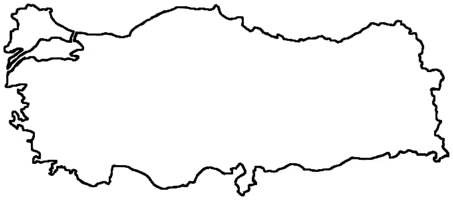
|
The Society of Folk Dance Historians (SFDH)
Choreogeography:
[
Home |
About |
Encyclopedia | CLICK AN IMAGE TO ENLARGE |

|
 For centuries, Turkey was one of the most mysterious, fabled, and feared countries of europe. Turkish warriors terrorized the land from Central Europe to Asia Minor and North Africa, spreading their culture, religion, language, and arts far beyond prtesent-day Turkey. The Ottoman Empire occupied the Balkan Peninsula from a hundred years before before Columbus until World War I – some 500 years. Much of today's culture and attitudes in the area are still strongly influenced by that occupation.
For centuries, Turkey was one of the most mysterious, fabled, and feared countries of europe. Turkish warriors terrorized the land from Central Europe to Asia Minor and North Africa, spreading their culture, religion, language, and arts far beyond prtesent-day Turkey. The Ottoman Empire occupied the Balkan Peninsula from a hundred years before before Columbus until World War I – some 500 years. Much of today's culture and attitudes in the area are still strongly influenced by that occupation.
The presence of the Ottomans resisted the influence of the European Renaissance, preserving the older forms of dance, which did not conceive of couples dancing together, and of music, whose rhythms and tones, played on ancient instruments, seem archaic and strange to the Western ear.
Modern Turkey was literally created in the fifteen years between 1923 and 1938, driven by the tireless efforts of Mustafa Kemal Ataturk. This remarkable man – warrior, statesman, politician, authoritarian, reformer – almost single-handedly pulled Turkey into the 20th Century from 1,500 years of oppressive Medieval Muslim tradition. He granted equal rights to women, both socially and politically, abolished polygamy, separated church and state, secularized the legal system, abolished the sultanate, mandated universal education, and even created a Western-style alphabet, personally teaching hundreds of his citizens to read. He even banned the fez, required men to wear hats (as men did in Europe), and proclaimed the Foxtrot as the proper dance of society, all aimed at reducing the influence of İslam on the Turkish state. That he succeeded is testimony to his personality and vision.
 Turkey is a peninsula with its eastern end anchored in the highlands of Mount Ararat, legendary resting place of Noah's Ark, the western end of a bridge to Europe. To the north lies the Black Sea and the Ukraine, to the south are the ancient Mediterranean and Agean Seas, invasionn routes for Romans, Greeks, and others from earliest history.
Turkey is a peninsula with its eastern end anchored in the highlands of Mount Ararat, legendary resting place of Noah's Ark, the western end of a bridge to Europe. To the north lies the Black Sea and the Ukraine, to the south are the ancient Mediterranean and Agean Seas, invasionn routes for Romans, Greeks, and others from earliest history.
İstanbul, ancient city of mystery, eastern end of the famed Orient Express, formerly Constantinople, formerly Byzantium, is the heart of Turkey. Few cities of the world have such a story to tell or have wielded so much influence on civilization. If one traveled only here, Turkey would be revealed.
The Bosporus is a waterway connecting the Black Sea with the Mediterranean, one of the world's major shipping routes. On its journey it opens to become the Sea of Marmara, and it is here that İstanbul straddles the Bosporus. Exquisite mosques and museums dislpaying the highly developed arts of İslam, teeming marketplaces, quaint shops, and ancient structures are everywhere.
Inland Turkey is a high plateau fringed by mountains, inhabited by farmers and shepherds. Along the northern Black Sea coast, fishing is the major livelihood. Here we find the unique Pontic dance forms, trembling with intense energy. The southeast is a rolling plateau, part of the Fertile Crescent, cherished for thousands of years for its productivity. Along the Mediterranean coast are ancient Greek and Roman ruins, testimony to their civilizations.
Turks take their dancing seriously, surrendering themselves totally in a frenzy of intense energy to the lure and spell of the dance, accompanied by various instruments, including the saz, zurna, oud, tupan, and other instruments of ageless tradition. No hesitant movements here, testing the ground or cautiously approaching a potential enemy; the Turkish dance moves with strength and intensity, firmly into the ground. Even when a leg is raised, the foot is pointed in an almost balletic stretch; no relaxed foot position here.
As the source of much of the traditions of dance, music, and folklore in the Balkans, Turkey requires special attention by anyone interested in the cultures of the Balkans. It is the source and once entered will both explain and puzzle anyone bold enough to go there. The Ottoman Empire was the major factor in the distribution of traditional dance forms today, preventing the influence of the northern European Renaissance from changing the ageless chain dance.
DOCUMENTS
- Richard Duree, an article.
- Turkey, a country.
Used with permission of the author.
This page © 2018 by Ron Houston.
Please do not copy any part of this page without including this copyright notice.
Please do not copy small portions out of context.
Please do not copy large portions without permission from Ron Houston.